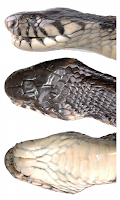 |
| Naja (Boulengerina) peroescobari |
Abstract
The Cobra-Preta (black snake in Portuguese) of Sao Tomé Island in the Gulf of Guinea has historically been referred to as Naja (Boulengerina) melanoleuca (Squamata: Elapidae). Its presence on the island has been traditionally explained as an introduction from the mainland by Portuguese settlers, supposedly to control the rat population. This explanation has been widely accepted by local authorities and even international conservation agencies. The taxonomic identity of this snake has remained undisputed by all taxonomists who have published about it, with the exception of L. Capocaccia in 1961. Arguments supporting the human introduction hypothesis are weak and are contradicted by historical, morphological and molecular data. Further, the biogeographic history of the Gulf of Guinea oceanic islands and recent insights on the taxonomic identity and evolutionary history of other taxonomic groups occurring there suggest that the Cobra-Preta, in fact, represents a distinct lineage of the melanoleuca group, endemic to São Tomé. We here describe the Cobra Preta as a new species. The new species differs from N. (B.) melanoleuca, its sister species, by a distinct coloration ventral pattern and the type of contact of the sublingual scales. Data on the toxicology, distribution, ecology, folklore and conservation status of the new species are presented.
Keywords: Reptilia, Naja, Boulengerina, taxonomy, São Tomé & Príncipe, conservation, Naja (Boulengerina) peroescobari sp. nov.
 |
| FIGURE 4. Holotype of Naja (Boulengerina) peroescobari sp. nov. (MUHNAC / MB 03 – 001065). |
 |
| FIGURE 5. Live picture of Naja (Boulengerina) peroescobari sp nov. from near Santa Josefina. Specimen not collected. Photo by Tiziano Pisoni. |
Luis M. P. Ceríaco, Mariana P. Marques, Andreas Schmitz and Aaron M. Bauer. 2017. The “Cobra-preta” of São Tomé Island, Gulf of Guinea, is A New Species of Naja Laurenti, 1768 (Squamata: Elapidae). Zootaxa. 4324(1); 121–141. DOI: 10.11646/zootaxa.4324.1.7


